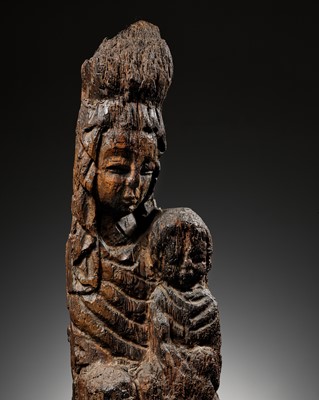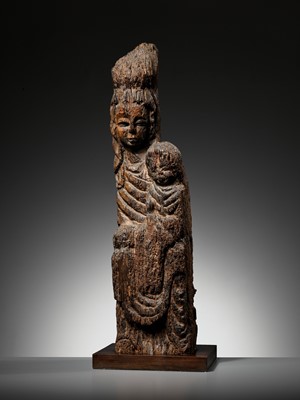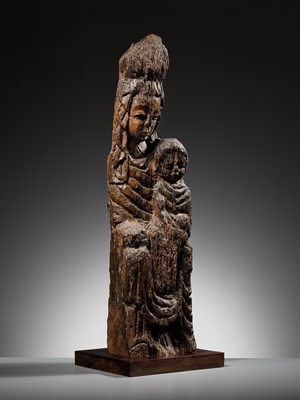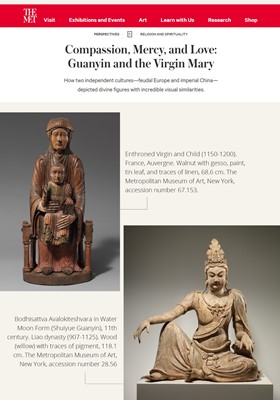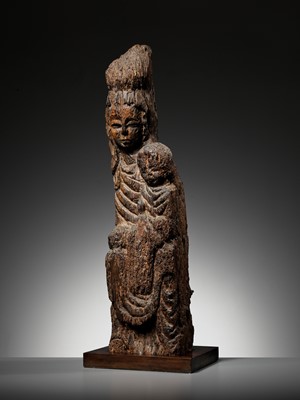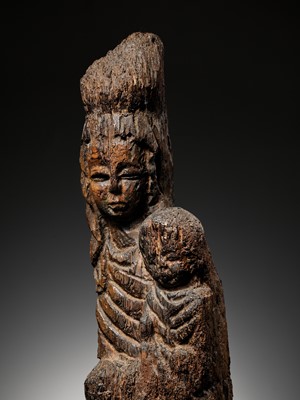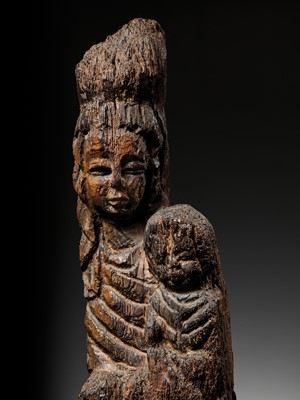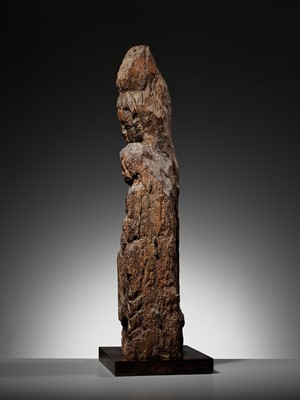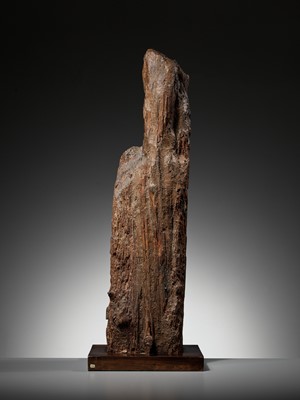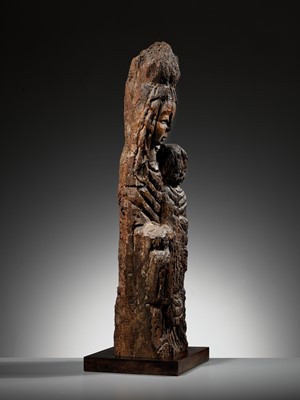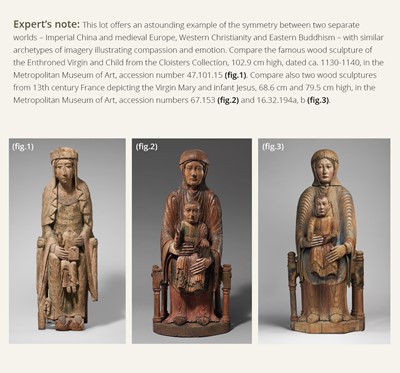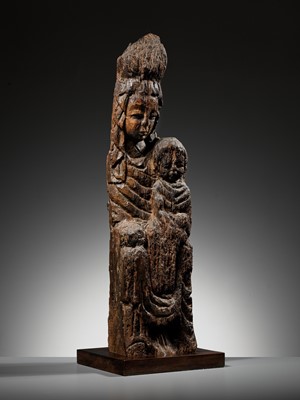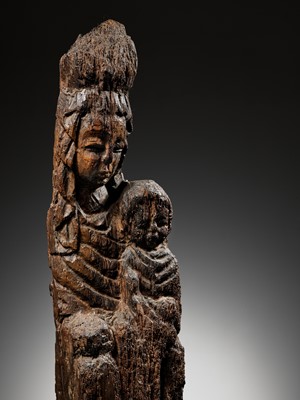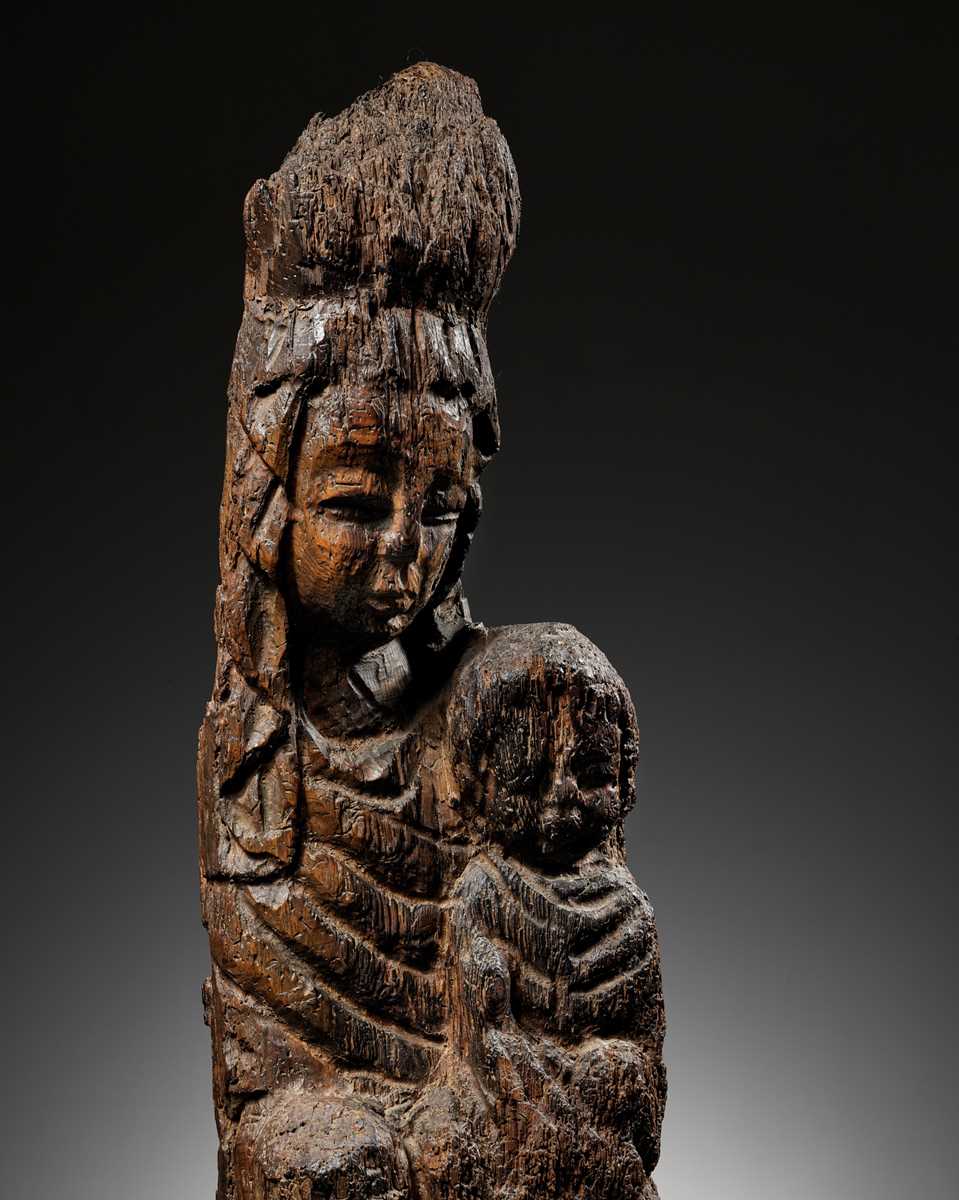13th Dec, 2023 13:00
Fine Asian Art Holiday Sale
69
A LARGE WOOD FIGURE OF SONGZI GUANYIN AND CHILD, CHINA, EARLY MING DYNASTY, 14TH-15TH CENTURY
明初十四至十五世紀大型送子觀音木像
Sold for €2,600
including Buyer's Premium
Boldly carved as Guanyin with hair piled up into a high topknot beneath her flowing cowl, holding a child seated in her lap, both wearing voluminous robes with deeply carved folds, their faces with wide heavy-lidded eyes, broad noses, and full lips. The soft wood of an attractive grain with a rich, naturally grown patina overall.
Provenance: From an old private collection on the Upper East Side of Manhattan, New York, and Bridgehampton, NY, acquired before 1979, and thence by descent in the family. A copy of a signed insurance declaration, on the letterhead of the Chubb Group, dated 25 August 1978, describing the present lot as an 'Unusual Large Wooden Figure of Kuan Yin', accompanies this lot.
Condition: Extensive wear, weathering and erosion, worming, losses, chips, and natural imperfections including age cracks. The condition of this statue is commensurate with age and contributes to its unique beauty. The aged wood has seen extensive weathering, which displays exceptionally well.
Weight: 13.8 kg (incl. stand)
Dimensions: Height 92.5 cm (excl. stand) and 95.2 cm (incl. stand)
With a fitted wood stand. (2)
Please click here to read the full description
The Songzi representation of Guanyin, or the 'Bringer of Sons,' is identifiable by the boy seated on her knee. Male children were extremely important to Confucian family structure. They ensured not only the continuity of family and clan, but that there would be uninterrupted generations to carry on the rituals of ancestral worship. The Child-Giving Guanyin was prayed to by worshipers for healthy children and intelligent male heirs. Extant depictions of Songzi Guanyin from the later Ming dynasty are known in various materials, including bronze, wood, stone, and ivory, but such an early example must be considered extremely rare.
Quoted from 'Compassion, Mercy, and Love: Guanyin and the Virgin Mary - How two independent cultures – feudal Europe and imperial China – depicted divine figures with incredible visual similarities.' By Kevin D. Pham, Metropolitan Museum of Art, New York, May 7, 2021:
‘During the Middle Ages – a period of over one thousand years – people of various cultures across the world practiced independent religious faiths, ranging from western feudal Europe to imperial China, while also maintaining cross-cultural exchange. Surprisingly, certain works of art in both western Christian and eastern Buddhist cultures seem to share visual similarities. Both contexts produced images of divine figures that represent concepts like compassion, mercy, and love: the Virgin Mary in medieval Europe, and Guanyin in imperial China.’
‘These examples pose interesting questions about how pre-modern artists visualized different aspects of divinity in their respective cultural contexts. The Christian and Buddhist devout understood the Virgin Mary and Guanyin, respectively, in similar manners and archetypes of imagery, despite the fact that they did not directly influence one another until later periods of Imperialism and Colonialism in Asia. Centuries of shifts in these representations illustrate how people across the world have envisioned human compassion and mortal emotions.’ (article continued below)
‘The Virgin Mary’, Jesus Christ’s mother, was a popular focus of personal devotion in western Christianity. She was often depicted with her infant child, emphasizing her role as a holy maternal figure and mediator between humanity and the divine. Through this easily understood archetype, she became a popular intercessor for devout Christians across Medieval Europe, where various types of ‘Virgin and Child’ works of art proliferated.
Guanyin is the Chinese translation of Avalokiteshvara, the bodhisattva of compassion. Bodhisattvas are enlightened beings who chose to stay on earth as accessible examples for Buddhist faithful to follow. Originally depicted as a male or gender-neutral entity able to take on thirty-three manifestations, Avalokiteshvara is a compassionate savior who hears the woes of humankind, regardless of age, gender, or social class. However, in imperial China, Guanyin became increasingly cemented as a female figure. Similar to the Virgin Mary, Guanyin became a popular intercessor for humanity to understand divine salvation.
Enthroned Virgin and Child (1150-1200), currently on display at The Met Cloisters, is a counterpart to a sculpture from about 1175 to 1200 included in the exhibition Crossroads: Power and Piety. In both sculptures, mother and child are rendered in a stiff and rigid form that typifies the theological concept Sedes Sapientiae or “Throne of Wisdom.” The infant Jesus, depicted as a diminutive mature figure rather than a child, represents divine wisdom and is seated upon the Virgin, who acts as his throne. Both the Virgin and Child’s emotionless expressions, coupled with the strongly linear symmetry, suggest the timeless permanence of divine authority in the Christian context.
The eleventh-century Bodhisattva Avalokiteshvara in Water Moon Form (Shuiyue Guanyin), currently on display in the Met Gallery 208, depicts Avalokiteshvara in a relaxed, leisurely pose, with one knee raised and the other crossed in front. This posture represents the “Water Moon” manifestation of the bodhisattva in his personal paradise. Avalokiteshvara is adorned within an ornate crown and necklace. Relaxed but strong and formative, Avalokiteshvara beckons the audience forward, ready to hear the cries of the world.
Both of these sculptures would have been placed in public churches or temples. The Virgin and Child also might have been carried in religious processions outside the architectural setting of the church, while Avalokiteshvara would likely have been shown at a monastery altar. Despite their different poses, both figures convey a divinity distinctly removed from the real experiences of mortal humans.'
Expert’s note: This lot offers an astounding example of the symmetry between two separate worlds – Imperial China and medieval Europe, Western Christianity and Eastern Buddhism – with similar archetypes of imagery illustrating compassion and emotion. Compare the famous wood sculpture of the Enthroned Virgin and Child from the Cloisters Collection, 102.9 cm high, dated ca. 1130-1140, in the Metropolitan Museum of Art, accession number 47.101.15. Compare also two wood sculptures from 13th century France depicting the Virgin Mary and infant Jesus, 68.6 cm and 79.5 cm high, in the Metropolitan Museum of Art, accession numbers 67.153 and 16.32.194a, b.
点此阅读中文翻译 (Chinese Translation)
明初大型送子觀音木像
觀音,髮髻高束,膝上抱著一個孩子;兩人都穿著寬大的衣袍,衣紋流暢;眼睛微閉,表情安詳。柔軟的木材,紋理迷人,整體具有自然包漿。
來源:來自紐約曼哈頓上東區和紐約州布里奇漢普頓的私人舊收藏,於 1979 年之前購得,在同一家族保存。該拍品隨附一份帶有Chubb Group安達集團出具的的保險聲明副本,日期為 1978 年 8 月 25 日,將本拍品描述為“不尋常的大型木觀音像”。
品相:大面積磨損、風化和侵蝕、蠕蟲、損失、碎裂和自然缺陷,包括老化裂紋。
重量:13.8 公斤 (含底座)
尺寸:高 92.5 厘米 (不含底座) 與95.2 厘米 含底座)
木底座 (2)
Boldly carved as Guanyin with hair piled up into a high topknot beneath her flowing cowl, holding a child seated in her lap, both wearing voluminous robes with deeply carved folds, their faces with wide heavy-lidded eyes, broad noses, and full lips. The soft wood of an attractive grain with a rich, naturally grown patina overall.
Provenance: From an old private collection on the Upper East Side of Manhattan, New York, and Bridgehampton, NY, acquired before 1979, and thence by descent in the family. A copy of a signed insurance declaration, on the letterhead of the Chubb Group, dated 25 August 1978, describing the present lot as an 'Unusual Large Wooden Figure of Kuan Yin', accompanies this lot.
Condition: Extensive wear, weathering and erosion, worming, losses, chips, and natural imperfections including age cracks. The condition of this statue is commensurate with age and contributes to its unique beauty. The aged wood has seen extensive weathering, which displays exceptionally well.
Weight: 13.8 kg (incl. stand)
Dimensions: Height 92.5 cm (excl. stand) and 95.2 cm (incl. stand)
With a fitted wood stand. (2)
Please click here to read the full description
The Songzi representation of Guanyin, or the 'Bringer of Sons,' is identifiable by the boy seated on her knee. Male children were extremely important to Confucian family structure. They ensured not only the continuity of family and clan, but that there would be uninterrupted generations to carry on the rituals of ancestral worship. The Child-Giving Guanyin was prayed to by worshipers for healthy children and intelligent male heirs. Extant depictions of Songzi Guanyin from the later Ming dynasty are known in various materials, including bronze, wood, stone, and ivory, but such an early example must be considered extremely rare.
Quoted from 'Compassion, Mercy, and Love: Guanyin and the Virgin Mary - How two independent cultures – feudal Europe and imperial China – depicted divine figures with incredible visual similarities.' By Kevin D. Pham, Metropolitan Museum of Art, New York, May 7, 2021:
‘During the Middle Ages – a period of over one thousand years – people of various cultures across the world practiced independent religious faiths, ranging from western feudal Europe to imperial China, while also maintaining cross-cultural exchange. Surprisingly, certain works of art in both western Christian and eastern Buddhist cultures seem to share visual similarities. Both contexts produced images of divine figures that represent concepts like compassion, mercy, and love: the Virgin Mary in medieval Europe, and Guanyin in imperial China.’
‘These examples pose interesting questions about how pre-modern artists visualized different aspects of divinity in their respective cultural contexts. The Christian and Buddhist devout understood the Virgin Mary and Guanyin, respectively, in similar manners and archetypes of imagery, despite the fact that they did not directly influence one another until later periods of Imperialism and Colonialism in Asia. Centuries of shifts in these representations illustrate how people across the world have envisioned human compassion and mortal emotions.’ (article continued below)
‘The Virgin Mary’, Jesus Christ’s mother, was a popular focus of personal devotion in western Christianity. She was often depicted with her infant child, emphasizing her role as a holy maternal figure and mediator between humanity and the divine. Through this easily understood archetype, she became a popular intercessor for devout Christians across Medieval Europe, where various types of ‘Virgin and Child’ works of art proliferated.
Guanyin is the Chinese translation of Avalokiteshvara, the bodhisattva of compassion. Bodhisattvas are enlightened beings who chose to stay on earth as accessible examples for Buddhist faithful to follow. Originally depicted as a male or gender-neutral entity able to take on thirty-three manifestations, Avalokiteshvara is a compassionate savior who hears the woes of humankind, regardless of age, gender, or social class. However, in imperial China, Guanyin became increasingly cemented as a female figure. Similar to the Virgin Mary, Guanyin became a popular intercessor for humanity to understand divine salvation.
Enthroned Virgin and Child (1150-1200), currently on display at The Met Cloisters, is a counterpart to a sculpture from about 1175 to 1200 included in the exhibition Crossroads: Power and Piety. In both sculptures, mother and child are rendered in a stiff and rigid form that typifies the theological concept Sedes Sapientiae or “Throne of Wisdom.” The infant Jesus, depicted as a diminutive mature figure rather than a child, represents divine wisdom and is seated upon the Virgin, who acts as his throne. Both the Virgin and Child’s emotionless expressions, coupled with the strongly linear symmetry, suggest the timeless permanence of divine authority in the Christian context.
The eleventh-century Bodhisattva Avalokiteshvara in Water Moon Form (Shuiyue Guanyin), currently on display in the Met Gallery 208, depicts Avalokiteshvara in a relaxed, leisurely pose, with one knee raised and the other crossed in front. This posture represents the “Water Moon” manifestation of the bodhisattva in his personal paradise. Avalokiteshvara is adorned within an ornate crown and necklace. Relaxed but strong and formative, Avalokiteshvara beckons the audience forward, ready to hear the cries of the world.
Both of these sculptures would have been placed in public churches or temples. The Virgin and Child also might have been carried in religious processions outside the architectural setting of the church, while Avalokiteshvara would likely have been shown at a monastery altar. Despite their different poses, both figures convey a divinity distinctly removed from the real experiences of mortal humans.'
Expert’s note: This lot offers an astounding example of the symmetry between two separate worlds – Imperial China and medieval Europe, Western Christianity and Eastern Buddhism – with similar archetypes of imagery illustrating compassion and emotion. Compare the famous wood sculpture of the Enthroned Virgin and Child from the Cloisters Collection, 102.9 cm high, dated ca. 1130-1140, in the Metropolitan Museum of Art, accession number 47.101.15. Compare also two wood sculptures from 13th century France depicting the Virgin Mary and infant Jesus, 68.6 cm and 79.5 cm high, in the Metropolitan Museum of Art, accession numbers 67.153 and 16.32.194a, b.
点此阅读中文翻译 (Chinese Translation)
明初大型送子觀音木像
觀音,髮髻高束,膝上抱著一個孩子;兩人都穿著寬大的衣袍,衣紋流暢;眼睛微閉,表情安詳。柔軟的木材,紋理迷人,整體具有自然包漿。
來源:來自紐約曼哈頓上東區和紐約州布里奇漢普頓的私人舊收藏,於 1979 年之前購得,在同一家族保存。該拍品隨附一份帶有Chubb Group安達集團出具的的保險聲明副本,日期為 1978 年 8 月 25 日,將本拍品描述為“不尋常的大型木觀音像”。
品相:大面積磨損、風化和侵蝕、蠕蟲、損失、碎裂和自然缺陷,包括老化裂紋。
重量:13.8 公斤 (含底座)
尺寸:高 92.5 厘米 (不含底座) 與95.2 厘米 含底座)
木底座 (2)
Zacke Live Online Bidding
Our online bidding platform makes it easier than ever to bid in our auctions! When you bid through our website, you can take advantage of our premium buyer's terms without incurring any additional online bidding surcharges.
To bid live online, you'll need to create an online account. Once your account is created and your identity is verified, you can register to bid in an auction up to 12 hours before the auction begins.
Intended Spend and Bid Limits
When you register to bid in an online auction, you will need to share your intended maximum spending budget for the auction. We will then review your intended spend and set a bid limit for you. Once you have pre-registered for a live online auction, you can see your intended spend and bid limit by going to 'Account Settings' and clicking on 'Live Bidding Registrations'.
Your bid limit will be the maximum amount you can bid during the auction. Your bid limit is for the hammer price and is not affected by the buyer’s premium and VAT. For example, if you have a bid limit of €1,000 and place two winning bids for €300 and €200, then you will only be able to bid €500 for the rest of the auction. If you try to place a bid that is higher than €500, you will not be able to do so.
Online Absentee and Telephone Bids
You can now leave absentee and telephone bids on our website!
Absentee Bidding
Once you've created an account and your identity is verified, you can leave your absentee bid directly on the lot page. We will contact you when your bids have been confirmed.
Telephone Bidding
Once you've created an account and your identity is verified, you can leave telephone bids online. We will contact you when your bids have been confirmed.
Classic Absentee and Telephone Bidding Form
You can still submit absentee and telephone bids by email or fax if you prefer. Simply fill out the Absentee Bidding/Telephone bidding form and return it to us by email at office@zacke.at or by fax at +43 (1) 532 04 52 20. You can download the PDF from our Upcoming Auctions page.
How-To Guides
How to Create Your Personal Zacke Account
How to Register to Bid on Zacke Live
How to Leave Absentee Bids Online
How to Leave Telephone Bids Online
中文版本的操作指南
创建新账号
注册Zacke Live在线直播竞拍(免平台费)
缺席投标和电话投标
Third-Party Bidding
We partner with best-in-class third-party partners to make it easy for you to bid online in the channel of your choice. Please note that if you bid with one of our third-party online partners, then there will be a live bidding surcharge on top of your final purchase price. You can find all of our fees here. Here's a full list of our third-party partners:
- 51 Bid Live
- EpaiLive
- ArtFoxLive
- Invaluable
- LiveAuctioneers
- the-saleroom
- lot-tissimo
- Drouot
Please note that we place different auctions on different platforms. For example, in general, we only place Chinese art auctions on 51 Bid Live.
Bidding in Person
You must register to bid in person and will be assigned a paddle at the auction. Please contact us at office@zacke.at or +43 (1) 532 04 52 for the latest local health and safety guidelines.
